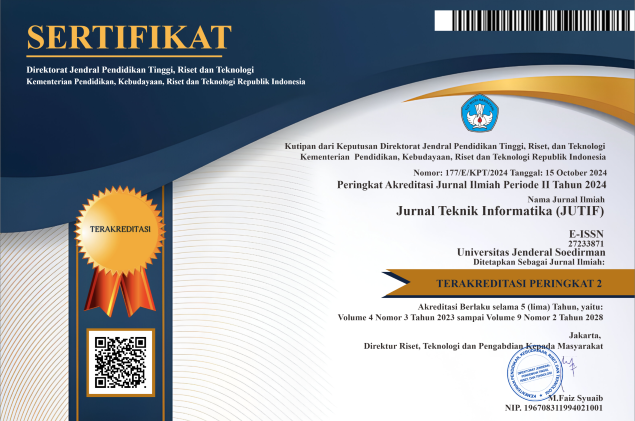A Hybrid Approach for Recommender Systems Based on Alternating Least Squares and CatBoost
DOI:
https://doi.org/10.52436/1.jutif.2025.6.4.5002Keywords:
ALS, CatBoost, collaborative filtering, hybrid model, MovieLens, recommender systemAbstract
This study aims to improve the accuracy of movie rating predictions by applying and combining collaborative filtering and machine learning techniques in a hybrid recommender system. The research utilizes the MovieLens dataset to implement two distinct approaches: the Alternating Least Squares (ALS) matrix factorization model and the CatBoost gradient boosting model. The ALS model is trained to capture latent user–item interactions, while CatBoost leverages nonlinear relationships using user and item features. A simple hybrid strategy averages the predictions from both models to evaluate potential performance gains. Experimental results show that the hybrid approach achieves lower error metrics compared to either model individually, with Root Mean Squared Error (RMSE) and Mean Absolute Error (MAE) values of 0.828 and 0.666, respectively. This demonstrates that combining latent factor models with tree-based learning can effectively reduce prediction errors by exploiting complementary strengths. The novelty of this research lies in its efficient yet effective hybridization strategy that improves recommendation quality without complex ensembling techniques. The findings suggest that even lightweight model fusion can significantly enhance predictive accuracy in recommender systems and may be adapted for other domains where combining linear and nonlinear modeling is beneficial. This research contributes to the field of Informatics and Computer Science by demonstrating that a lightweight hybridization of latent factor models and tree-based learning can significantly improve recommender system accuracy while offering practical implications for real-world digital applications.
Downloads
References
F. A. Darmawan and Z. K. A. Baizal, “An Approach to a Group Movie Recommender System using Matrix Factorization-based Collaborative Filtering,” JURNAL INFOTEL, vol. 16, no. 2, pp. 243–254, May 2024, doi: 10.20895/infotel.v16i2.1126.
B. T. Imani and E. B. Setiawan, “Recommender System Based on Matrix Factorization on Twitter Using Random Forest (Case Study: Movies on Netflix),” International Journal on Information and Communication Technology (IJoICT), vol. 8, no. 2, pp. 11–21, Dec. 2022, doi: 10.21108/ijoict.v8i2.655.
S. Kulkarni and S. F. Rodd, “Context Aware Recommendation Systems: A review of the state of the art techniques,” Comput Sci Rev, vol. 37, p. 100255, Aug. 2020, doi: 10.1016/j.cosrev.2020.100255.
N. Mehrabi, F. Morstatter, N. Saxena, K. Lerman, and A. Galstyan, “A Survey on Bias and Fairness in Machine Learning,” ACM Comput Surv, vol. 54, no. 6, pp. 1–35, Jul. 2022, doi: 10.1145/3457607.
Y. Hu, Y. Koren, and C. Volinsky, “Collaborative Filtering for Implicit Feedback Datasets,” in 2008 Eighth IEEE International Conference on Data Mining, IEEE, Dec. 2008, pp. 263–272. doi: 10.1109/ICDM.2008.22.
A. V. Dorogush, V. Ershov, and A. Gulin, “CatBoost: gradient boosting with categorical features support,” in NIPS’18: Proceedings of the 32nd International Conference on Neural Information Processing Systems, ACM, 2018.
H. Al-Bashiri, M. A. Abdulgabber, A. Romli, and F. Hujainah, “Collaborative Filtering Recommender System: Overview and Challenges,” Adv Sci Lett, vol. 23, no. 9, pp. 9045–9049, Sep. 2017, doi: 10.1166/asl.2017.10020.
S. Annisa, D. P. Rini, and A. Abdiansah, “Collaborative Filtering Recommendation System Using A Combination of Clustering and Association Rule Mining,” Journal of Information Systems and Informatics, vol. 6, no. 3, pp. 1499–1516, Sep. 2024, doi: 10.51519/journalisi.v6i3.802.
A. Fareed, S. Hassan, S. B. Belhaouari, and Z. Halim, “A collaborative filtering recommendation framework utilizing social networks,” Machine Learning with Applications, vol. 14, p. 100495, Dec. 2023, doi: 10.1016/j.mlwa.2023.100495.
J. Xu, “Analysis of Social Media Algorithm Recommendation System,” Studies in Social Science & Humanities, vol. 1, no. 3, Oct. 2022, doi: 10.56397/SSSH.2022.10.06.
Y. A. Bekeneva and T. U. Eze, “Improved Social Network User Recommendation System—The Machine Learning Approach,” in INTELS’22, Basel Switzerland: MDPI, Jun. 2023, p. 13. doi: 10.3390/engproc2023033013.
A. Anandhan, M. A. Ismail, L. Shuib, W. S. N. Aiza, and M. M. Elaish, “Social Media Recommender Systems (SMRS): A Bibliometric Analysis Study 2000–2021,” IEEE Access, vol. 10, pp. 35479–35497, 2022, doi: 10.1109/ACCESS.2022.3161497.
A. A. Patoulia, A. Kiourtis, A. Mavrogiorgou, and D. Kyriazis, “A Comparative Study of Collaborative Filtering in Product Recommendation,” Emerging Science Journal, vol. 7, no. 1, pp. 1–15, Oct. 2022, doi: 10.28991/ESJ-2023-07-01-01.
I. T. Afolabi, O. S. Makinde, and O. O. Oladipupo, “Semantic Web mining for Content-Based Online Shopping Recommender Systems,” International Journal of Intelligent Information Technologies, vol. 15, no. 4, pp. 41–56, Oct. 2019, doi: 10.4018/IJIIT.2019100103.
W.-E. Kong, T.-E. Tai, P. Naveen, and H. A. Santoso, “Performance Evaluation on E-Commerce Recommender System based on KNN, SVD, CoClustering and Ensemble Approaches,” Journal of Informatics and Web Engineering, vol. 3, no. 3, pp. 63–76, Oct. 2024, doi: 10.33093/jiwe.2024.3.3.4.
F. T. Abdul Hussien, A. M. S. Rahma, and H. B. Abdul Wahab, “Recommendation Systems For E-commerce Systems An Overview,” J Phys Conf Ser, vol. 1897, no. 1, p. 012024, May 2021, doi: 10.1088/1742-6596/1897/1/012024.
S. Gosh, N. Nahar, M. A. Wahab, M. Biswas, M. S. Hossain, and K. Andersson, “Recommendation System for E-commerce Using Alternating Least Squares (ALS) on Apache Spark,” Springer, 2021, pp. 880–893. doi: 10.1007/978-3-030-68154-8_75.
M. O. Puspitaningtyas, K. Puspita, Y. Alkhalifi, and Y. A. Wardani, “Implementation of Support Vector Machine, Particle Swarm Optimization, And Naïve Bayes Algorithms in Sentiment Analysis of Product Reviews: A Case Study of e-Commerce Lazada,” Jurnal Riset Informatika, vol. 7, no. 2, pp. 30–37, Mar. 2025, doi: 10.34288/jri.v7i2.362.
E. Pantano, C.-V. Priporas, N. Stylos, and C. Dennis, “Facilitating tourists’ decision making through open data analyses: A novel recommender system,” Tour Manag Perspect, vol. 31, pp. 323–331, Jul. 2019, doi: 10.1016/j.tmp.2019.06.003.
N. S. F. Putri, A. P. Wibawa, H. Ar Rasyid, A. Nafalski, and U. R. Hasyim, “Boosting and bagging classification for computer science journal,” International Journal of Advances in Intelligent Informatics, vol. 9, no. 1, p. 27, Mar. 2023, doi: 10.26555/ijain.v9i1.985.
Y. Pristyanto, Z. Mukarabiman, and A. F. Nugraha, “Extreme Gradient Boosting Algorithm to Improve Machine Learning Model Performance on Multiclass Imbalanced Dataset,” JOIV : International Journal on Informatics Visualization, vol. 7, no. 3, pp. 710–715, Sep. 2023, doi: 10.30630/joiv.7.3.1102.
D. A. Setyarini, A. A. M. D. Gayatri, C. S. K. Aditya, and D. R. Chandranegara, “Stroke Prediction with Enhanced Gradient Boosting Classifier and Strategic Hyperparameter,” MATRIK : Jurnal Manajemen, Teknik Informatika dan Rekayasa Komputer, vol. 23, no. 2, pp. 477–490, Mar. 2024, doi: 10.30812/matrik.v23i2.3555.
D. N. Muhammady, H. A. E. Nugraha, V. R. S. Nastiti, and C. S. K. Aditya, “Students Final Academic Score Prediction Using Boosting Regression Algorithms,” Jurnal Ilmiah Teknik Elektro Komputer dan Informatika, vol. 10, no. 1, p. 154, Mar. 2024, doi: 10.26555/jiteki.v10i1.28352.
A. Abdolmaleki and M. H. Rezvani, “An optimal context-aware content-based movie recommender system using genetic algorithm: a case study on MovieLens dataset,” Journal of Experimental & Theoretical Artificial Intelligence, vol. 36, no. 8, pp. 1485–1511, Nov. 2024, doi: 10.1080/0952813X.2022.2153279.
M. T. Alam et al., “Comparative Analysis of Machine Learning based Filtering Techniques using MovieLens dataset,” Procedia Comput Sci, vol. 194, pp. 210–217, 2021, doi: 10.1016/j.procs.2021.10.075.
F. M. Harper and J. A. Konstan, “The MovieLens Datasets,” ACM Trans Interact Intell Syst, vol. 5, no. 4, pp. 1–19, Jan. 2016, doi: 10.1145/2827872.
H. A. Adyatma and Z. K. A. Baizal, “Book Recommender System Using Matrix Factorization with Alternating Least Square Method,” Journal of Information System Research (JOSH), vol. 4, no. 4, pp. 1286–1292, Jul. 2023, doi: 10.47065/josh.v4i4.3816.
N. P. Widyasprana, I. M. W. Wirawan, I. G. S. Astawa, and I. D. M. Bayu Atmaja Darmawan, “Analisis Algoritma ALS-MF (Alternating Least Square Matrix Factorization) dengan SVD (Singular Value Decomposition) pada Metode Collaborative Filtering,” JELIKU (Jurnal Elektronik Ilmu Komputer Udayana), vol. 13, no. 2, p. 347, Jul. 2024, doi: 10.24843/JLK.2024.v13.i02.p12.
Y. Zhou, D. Wilkinson, R. Schreiber, and R. Pan, “Large-Scale Parallel Collaborative Filtering for the Netflix Prize,” in Algorithmic Aspects in Information and Management, Berlin, Heidelberg: Springer Berlin Heidelberg, pp. 337–348. doi: 10.1007/978-3-540-68880-8_32.
M. A. Harriz, N. V. Akbariani, H. Setiyowati, and H. Santoso, “Classifying Village Fund in West Java, Indonesia Using Catboost Algorithm,” Jurnal Indonesia : Manajemen Informatika dan Komunikasi, vol. 4, no. 2, pp. 691–697, May 2023, doi: 10.35870/jimik.v4i2.269.
A. F. L. Ptr, M. M. Siregar, and I. Daniel, “Analysis of Gradient Boosting, XGBoost, and CatBoost on Mobile Phone Classification,” Journal of Computer Networks, Architecture and High Performance Computing, vol. 6, no. 2, pp. 661–670, Apr. 2024, doi: 10.47709/cnahpc.v6i2.3790.
B. F. Azevedo, A. M. A. C. Rocha, and A. I. Pereira, “Hybrid approaches to optimization and machine learning methods: a systematic literature review,” Mach Learn, vol. 113, no. 7, pp. 4055–4097, Jul. 2024, doi: 10.1007/s10994-023-06467-x.
J. Paredes, D. Chávez, R. Isa-Jara, and D. Vargas, “A hybrid machine learning algorithm approach to predictive maintenance tasks: A comparison with machine learning algorithms,” Results in Engineering, vol. 26, p. 105137, Jun. 2025, doi: 10.1016/j.rineng.2025.105137.
Aditya Gumilar, Sri Suryani Prasetiyowati, and Yuliant Sibaroni, “Performance Analysis of Hybrid Machine Learning Methods on Imbalanced Data (Rainfall Classification),” Jurnal RESTI (Rekayasa Sistem dan Teknologi Informasi), vol. 6, no. 3, pp. 481–490, Jul. 2022, doi: 10.29207/resti.v6i3.4142.
Additional Files
Published
How to Cite
Issue
Section
License
Copyright (c) 2025 Fiddin Yusfida

This work is licensed under a Creative Commons Attribution 4.0 International License.



























